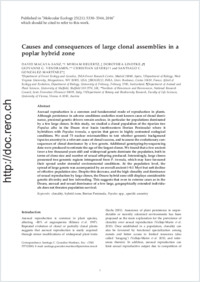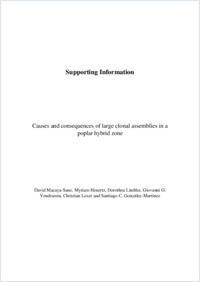Causes and consequences of large clonal assemblies in a poplar hybrid zone
- Macaya-Sanz, David Department of Forest Ecology and Genetics, INIA-Forest Research Centre, Madrid, Spain - Department of Biology, West Virginia University, Morgantown, WV, USA
- Heuertz, Myriam BIOGECO, INRA, Univ. Bordeaux, Cestas, France
- Lindtke, Dorothea Unit of Ecology and Evolution, Department of Biology, University of Fribourg, Switzerland - Department of Animal and Plant Sciences, University of Sheffield, UK
- Vendramin, Giovanni G. Institute of Biosciences and Bioresources, National Research Council, Sesto Fiorentino (Florence), Italy
- Lexer, Christian Unit of Ecology and Evolution, Department of Biology, University of Fribourg, Switzerland - Department of Botany and Biodiversity Research, Faculty of Life Sciences, University of Vienna, Austria
- González-Martínez, Santiago C. Department of Forest Ecology and Genetics, INIA-Forest Research Centre, Madrid, Spain - BIOGECO, INRA, Univ. Bordeaux, Cestas, France
-
01.11.2016
Published in:
- Molecular Ecology. - 2016, vol. 25, no. 21, p. 5330–5344
English
Asexual reproduction is a common and fundamental mode of reproduction in plants. Although persistence in adverse conditions underlies most known cases of clonal dominance, proximal genetic drivers remain unclear, in particular for populations dominated by a few large clones. In this study, we studied a clonal population of the riparian tree Populus alba in the Douro river basin (northwestern Iberian Peninsula) where it hybridizes with Populus tremula, a species that grows in highly contrasted ecological conditions. We used 73 nuclear microsatellites to test whether genomic background (species ancestry) is a relevant cause of clonal success, and to assess the evolutionary consequences of clonal dominance by a few genets. Additional genotyping-by-sequencing data were produced to estimate the age of the largest clones. We found that a few ancient (over a few thousand years old) and widespread genets dominate the population, both in terms of clone size and number of sexual offspring produced. Interestingly, large clones possessed two genomic regions introgressed from P. tremula, which may have favoured their spread under stressful environmental conditions. At the population level, the spread of large genets was accompanied by an overall ancient (>0.1 Myr) but soft decline of effective population size. Despite this decrease, and the high clonality and dominance of sexual reproduction by large clones, the Douro hybrid zone still displays considerable genetic diversity and low inbreeding. This suggests that even in extreme cases as in the Douro, asexual and sexual dominance of a few large, geographically extended individuals does not threaten population survival.
- Faculty
- Faculté des sciences et de médecine
- Department
- Département de Biologie
- Language
-
- English
- Classification
- Biological sciences
- License
- License undefined
- Identifiers
-
- RERO DOC 278417
- DOI 10.1111/mec.13850
- Persistent URL
- https://folia.unifr.ch/unifr/documents/305140
Other files
Statistics
Document views: 59
File downloads:
- lin_ccl.pdf: 105
- lin_ccl_sm.pdf: 110

